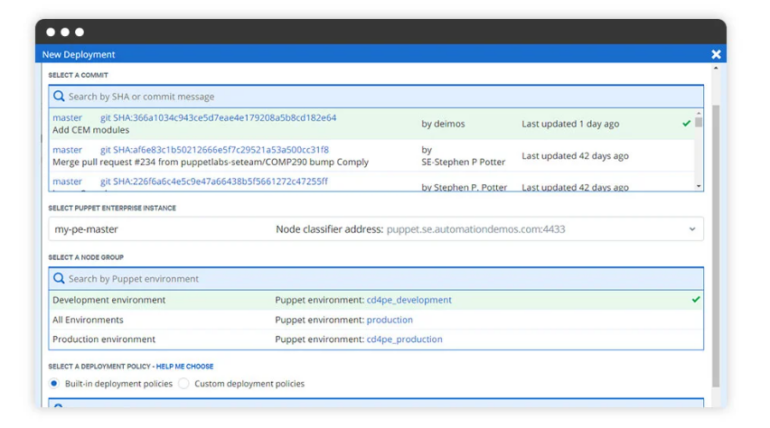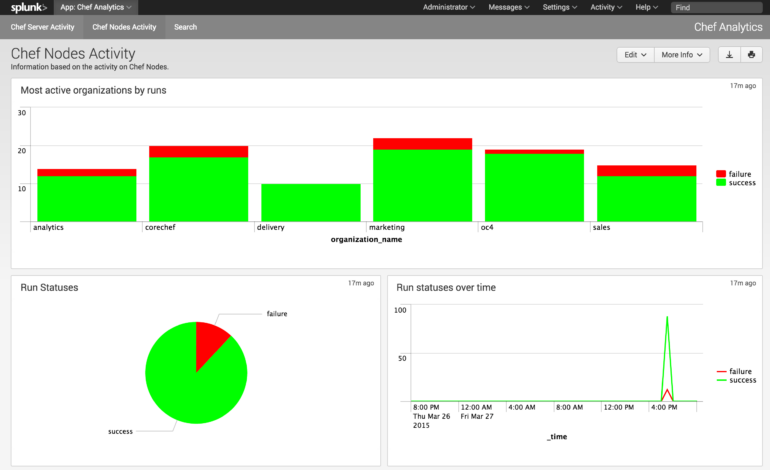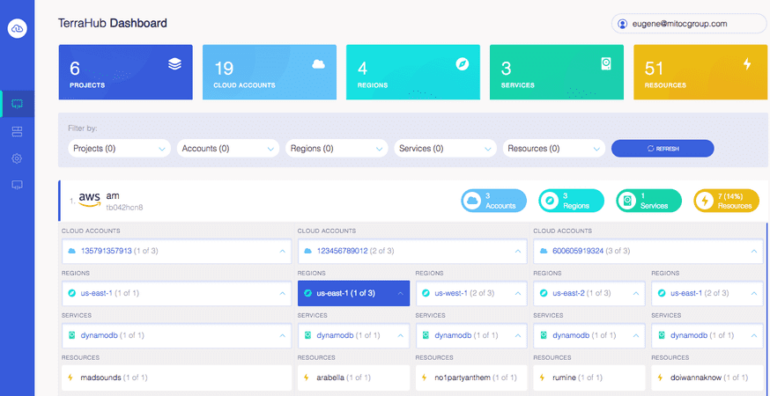Software developers and project managers can use infrastructure as code (IaC) software to automate the management and provisioning of infrastructure. By bypassing manual configuration, software development teams can enjoy lower costs, faster speed, and fewer errors. This guide will discuss the following infrastructure as code tools in terms of their features, pros, cons and pricing so you can pick the ideal solution for your needs:
- Puppet: A great option for teams seeking IaC software that can handle large-scale infrastructure and also has an established and supportive community.
- Chef: An excellent pick for developers seeking a flexible and advanced configuration management tool that relies on infrastructure as code to automate complex tasks.
- Terraform: An ideal solution for development teams seeking an open-source IaC tool for cloud-based environments.
Jump to:
Puppet

Puppet is an IaC tool that uses its own declarative language to define desired infrastructure states. It has a solid interface and reporting capabilities and is ideal for teams and organizations in charge of managing large-scale infrastructures.
Features of Puppet
Some of Puppet’s features that have made it a popular DevOps tool include:
- Multi-platform support.
- Real-time monitoring.
- Policy-as-code.
- Third-party integrations.
Puppet supports multiple platforms, including Windows, Linux, Microsoft Azure, AWS, GCP and more. The IaC software has real-time monitoring and reporting to help developers spot drift and compliance errors. It also leverages policy-as-code for streamlining and enforcing compliance. You can also extend Puppet’s functionality by integrating it with third-party cloud, infrastructure, secret management, policy-as-code and other services.
SEE: What is DevOps?
Pros of Puppet
Puppet’s pros include:
- Well-established community.
- Fast error fixes.
- Learnable language.
- Intuitive interface.
Since Puppet has been around since 2005, it has a large, well-established community that can offer support and resources for new users and those who stumble upon obstacles. Puppet highlights lines containing coding errors so they can be fixed quickly.
While Puppet’s use of its own declarative scripting language (DSL) can be a con for some newer users, the language is at least easy to learn and eventually write. Puppet’s user interface is also clean and easy to follow.
Cons of Puppet
Puppet’s cons include:
- Can be complicated to configure.
- Complexity – known for its steep learning curve.
- Requires some programming knowledge.
- Pricing.
Setting up Puppet can take some time and patience and requires users to be more hands-on than some simpler competing tools since it was designed more for system administrators than less technical users.
Puppet has a steep learning curve, and unless you have a programming background and knowledge of the Puppet DSL, you may have a hard time adapting to it. Additionally, since Puppet only has two versions, some teams may find the custom Enterprise pricing prohibitive if they want more advanced features.
Puppet Pricing
Project managers and developers can choose between Open-Source Puppet and Puppet Enterprise. The open-source version is free.
Puppet offers the Enterprise version via custom-priced plans. It comes with automation features, extensions and more. Get a custom Puppet Enterprise pricing quote.
Progress Chef

Progress Chef (formerly Chef) is a flexible configuration management tool with a large following that uses infrastructure as code. It is used by software developers, DevOps teams, system administrators and more to automate their infrastructure and applications’ configuration management.
Features of Chef
Chef has several features that make it a popular DevOps tool, including:
- Platform-agnostic.
- IaC features and adherence.
- Recipes and cookbooks.
- Chef Supermarket.
- Integrations with third-party DevOps tools.
Chef is a platform-agnostic programmer tool due to its system resource abstraction, allowing it to support different cloud platforms and operating systems. Due to its reliance on infrastructure as code, Chef keeps configuration consistent and repeatable and promotes version control via a host of version control tools.
Staying in line with the “Chef” name, the IaC tool relies on recipes and cookbooks. Recipes are specific actions/configurations, while cookbooks are recipe collections. Chef’s recipes and cookbooks keep configuration management simple for developers by letting them reuse code and embrace the power of modularity.
The Chef Supermarket is loaded with pre-built cookbooks to speed up configuration management. There is also a large community ecosystem that supplies users with best practices, cookbooks, modules and more. Chef is highly extensible, too, thanks to third-party integrations with Jenkins, CircleCI and other popular tools.
Pros of Chef
Some of Chef’s biggest advantages as an IaC tool include:
- Advanced configuration management capabilities.
- Extensibility.
- Community support.
- Versatile, offering greater control of configurations.
Some of Chef’s competition is best served for handling basic tasks. Chef, on the other hand, has advanced configuration management features to handle complex tasks, such as test driven development infrastructure deployment on-demand. Progress Chef also excels in extensibility as the programmer tool integrates with top DevOps tools like CircleCI, Jenkins, Bitbucket, GitHub and more.
If you are looking for an infrastructure as code tool with a large community that offers added support and resources, you will find just that with Chef. And if you are looking for an IaC tool that is flexible so you have more configuration control, Chef offers that, too, since it follows a code-driven approach.
Cons of Chef
Chef could improve in some areas as a developer tool, such as:
- Required experience level.
- Time investment.
- Expensive for small teams.
Yes, Chef was built to handle even the most complex tasks. But to unlock that functionality, you will face a steep learning curve. Remember that Chef was created with experienced programmers in mind, so it will take some time to learn. One thing that could help is taking a Ruby course prior to tackling Chef. Beyond the complexity obstacle, you may find Chef pricey, especially if you are part of a smaller development team with a limited budget.
Pricing of Chef
Developers can buy Chef directly through Progress or via a marketplace. Buy the IaC tool from Progress, and you can get a custom quote for the SaaS or on-premise option. Buy Chef from the Azure Marketplace, and you get three options:
- Two-Hour Test Drive: Try Chef for two hours for free.
- BYOL: Pay for Azure compute time and bring your own license.
- Custom Private Offer: Get a custom quote on Chef from Azure.
Buy Chef from the AWS Marketplace, and you have two options:
- BYOL: Pay for AWS compute time and bring your own license.
- Chef on AWS Marketplace: Get a Chef subscription on your AWS account. Software and usage fees start at $0.20 per hour or $189 yearly.
You can learn more about Chef in our Chef Configuration Management Tool Review.
Terraform

HashiCorp Terraform is an open-source IaC tool ideal for developers and teams comfortable working with the Go language who need strong infrastructure management for cloud-based environments.
Features of Terraform
Some of Terraform’s top features as a DevOps tool include:
- Support for multiple operating systems.
- Multi-cloud deployment.
- Network infrastructure management tools.
- Plenty of integrations for developer tools.
Terraform supports multiple operating systems, including Windows, macOS, Linus, FreeBSD, OpenBSD and more. You can use Terraform for multi-cloud deployment, and it also has features for managing network infrastructure, such as firewall policies and load balancer member pools. Terraform offers extensibility, too, through integrations with CI/CD pipelines, version control systems and other programmer tools.
Pros of Terraform
Terraform’s strengths include:
- Easy setup.
- Flexibile hosting and platform support.
- Repeatability and built-in modularity.
- Highly performant.
Terraform is easy to set up and is flexible, with support for Azure, AWS and other cloud providers. The infrastructure as code software’s use of modules promotes repeatability, and its use of the Go language makes it fast and efficient.
Cons of Terraform
Terraform’s weaknesses include:
- Onboarding can be difficult.
- Documentation could use improvement.
- On-premises performance not as good as cloud.
- State management is not optimal.
Terraform is ideal for developers familiar with the Go or Golang language. If you are not, you may find the language unusual and difficult to learn at the start, which can slow onboarding.
Some users have found Terraform’s documentation complex and hard to understand. And while it works well with clouds, Terraform may suffer some issues when working with on-premises services. Managing the state file in Terraform to avoid conflicts can also be tricky and result in unexpected behaviors.
Terraform pricing
Terraform has a self-managed open-source option that is always free. It also has paid cloud and self-managed plans:
- Free (cloud): Up to 500 resources per month. Has the essential features for getting started with IaC provisioning.
- Standard (cloud): Starts at $0.00014 per hour per resource. For developers or teams adopting IaC provisioning.
- Plus (cloud): Custom pricing. For enterprises needing scalability.
- Enterprise (self-managed): Custom pricing. For enterprises with added compliance and security needs.
SEE: Building your Platform Engineering practice on AWS with Terraform
What to look for in infrastructure as code software
With various IaC tools on the market, choosing the right one for your software development team may seem like a daunting task. How can you ensure you pick the proper infrastructure as code software? First, if your budget is limited, consider the cost as the pricing of IaC tools can vary greatly. Luckily, many have free trials you can sign up for to give the features a test drive, while others may have free plans with limited features.
If the cost of certain IaC software acts as a deterrent, remember that these developer tools can save your team plenty of money by eliminating the need for manual infrastructure setup and maintenance.
After considering cost, look for an infrastructure as code tool that is user-friendly with an intuitive interface. And lastly, look at its features. Standard features that the ideal IaC tool should have include automation that saves time and money while minimizing human error, built-in security (encryption, identity access management, data loss prevention, etc.), solid customer service and support and scalability (autoscaling, dynamic orchestration, rolling updates, etc.). The ideal IaC software should also have plenty of integrations with third-party developer tools and services, plus a library of plugins for added extensibility.
Final thoughts on the best infrastructure as code tools
The IaC tools listed above can help your software development team cut costs, increase speed and eliminate errors linked to manual configuration. Before picking an IaC tool from our list, review its features, pros, cons and pricing to ensure it is the right pick for you.
Source of Article



